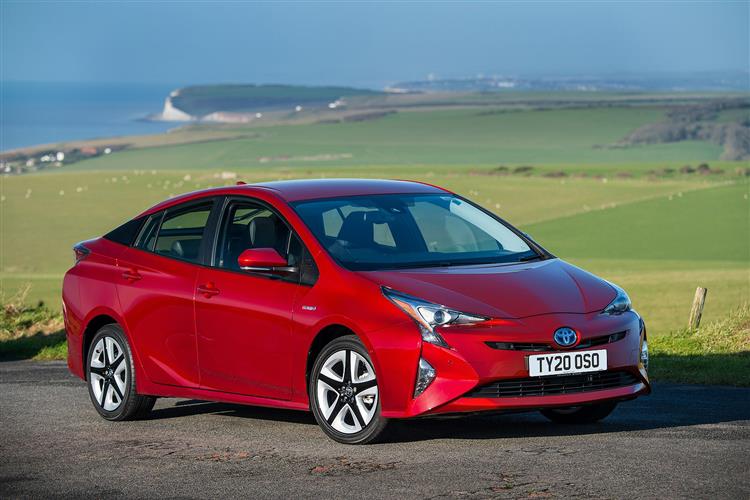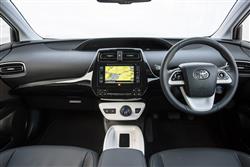A HY STANDARD (some text hidden) SECTIONED_new_toyotaprius_2020
By Jonathan Crouch
Introductionword count: 123
Toyota's Prius remains the most recognisable hybrid vehicle on our roads - and took a big step forward in this fourth generation guise, first launched in 2015. This MK4 model introduced a sleeker, more striking shape made possible by a stiffer, more sophisticated platform that helps to substantially improve the handling. The hybrid powertrain was clever too, hence a set of efficiency returns that established this car's superiority over comparably-priced diesel rivals. But the electrified vehicle marketplace was evolving in this period and the Prius had to continue to adapt. So in mid-2019, this 'XW50'-series design was enhanced with a general wash 'n brush-up and the novel option of AWD. That's the car we're going to look at here as a used buy.
Modelsword count: 14
5 door hatch (1.8 Hybrid - petrol) [Active, Business Edition, Business Edition Plus, Excel]
Historyword count: 929
Toyota's Prius was a car that in its first two decades of life re-shaped the global automotive landscape, bringing hybrid technology into the mainstream market, while focusing the motor industry's attention on the way its products could be cleaner and more efficient. The Prius did all that and in this rejuvenated MK4 model guise launched back in 2015, aimed to continue to set those standards, building upon quite a heritage of ingenuity. Here we're going to look at the lightly revised version of this fourth generation model, an update introduced in mid-2019. But first a bit of Prius history is needed for us to be able to put the importance of this model into some sort of context for you. To understand that, we need to turn the clock back to 1994 and a year in which the Toyota Motor Corporation made a decision aimed at fundamentally changing the way the world would drive. Engines, until that point exclusively fuel-based, could, the company decided, be developed in future to run with a combination of fuel and battery power. This so-called 'hybrid' solution would double efficiency, slash harmful emissions and create a whole new class of car. So was born the Prius, the world's very first mass-produced hybrid-powered vehicle, a model true to the Latin roots of its name in being very much 'ahead of its time'. So familiar are we with hybrids today that it's easy to forget how ground-breaking this technology was two decades ago. It certainly took Toyota a while to get it right, early prototypes catching fire, failing to start or merely silently expiring after just a few miles of use. But Chief Engineer Takeshi Uchiyamada and his 'G-21' development team persevered and by early 1997, the very first 'XW10'-series Prius model was ready for launch, a dumpy rather awkward-looking saloon that suited the Japanese market but rather puzzled everyone else. It was refined into 'XW11'-series form for overseas markets and global sales began in 2000. Toyota lost money on every one sold - but they weren't put off. The world would have a hybrid: it was simply a matter of time. And public perception - which began to change when movie stars like Leonardo DiCaprio, Cameron Diaz and Harrison Ford all became Prius people. Drive this car and it was clear to all that you cared about your world and its future, a statement that, as it turned out, a lot of people wanted to make. So many in fact that suddenly, what had begun as something GM's Vice Chairman described as 'an interesting curiosity' became a 'must-have' eco-fashion accessory, especially when a larger, more stylish second generation 'XW20'-series hatchback version was introduced in 2003 with significant gains in power and efficiency. 'You look smart: you should drive a Prius' the advertising told us - and very soon, millions were doing just that, the model's mass-market success sealed with the launch of a third generation 'XW30'-series version in 2009 that used a more efficient hybrid system and switched from 1.5 to pokier 1.8-litre petrol power, yet was still cleaner and more frugal. It formed the basis for an MPV version launched in 2012, the Prius+. By now, Toyota was ready to roll out hybrid technology across all its mainstream products - and share it with its Lexus luxury brand. As a result, by the end of 2015, the corporation had sold over eight million hybrids, 3.5 million of them Prius models. A success story then - to a point. For all its notoriety, the Prius remained a niche market choice in its first three generations of life. A great option if you wanted to demonstrate your concern for the Polar Ice Cap, but too compromised in handling and practicality to interest most mainstream family hatch folk. The suspension lurched through the corners. The CVT auto you had to have was thrashy. And the batteries took up boot space. What kind of car would this Toyota be if these things were sorted and the Prius brought up to date with a younger, more dynamic image, we wondered? Could it be made efficient enough to out-class a fresh generation of eco-minded diesel rivals? And would Toyota match its environmental credentials with an equally impressive showing in the fields of safety and connectivity? At its UK launch in the early Spring of 2016, the fourth generation 'XW50'-series Prius answered many of these questions, but it found itself operating in a very different market to its predecessors. In the years following, virtually every manufacturer introduced some kind of engine electrification - it was no longer any kind of novelty. And of course the other thing that happened after 2016 was that this car had to deal with its first really direct competitor, Hyundai's IONIQ hybrid, which had a more sophisticated automatic gearbox and could undercut this Prius in price. When that IONIQ model was updated in the Summer of 2019, Toyota decided it was time to fight back, introducing the lightly updated version of the MK4 model we're going to look at here. It was slightly smarter to look at and the cabin was carefully upgraded but the main change lay with the option - for the first time of this kind of car - of AWD for the few that wanted it. Otherwise, things were much as before and there was still the option of a pricier Plug-in version at the top of the range. Here though, we're concentrating on the standard 'self-charging' hybrid model that most will want. It sold in this updated MK4 form until late-2022.
What You Getword count: 605
The appearance of a Prius must not only be instantly recognisable but also aggressively futuristic. That is, after all, the whole point of it. Were you to want this technology packaged more conventionally, you'd be looking at one of Toyota's more ordinary models - maybe a Yaris, a Corolla or a RAV4. Here, in contrast, is the poster child of the eco revolution, complete in MK4 form with its familiar styling cues - the trademark arching roofline, the slab sides and the double rear screen. Yet somehow, with this XW50-series design, the Prius visual formula was reinterpreted, the concept behind this car reinvented for the modern era by a team of young Japanese designers who set out to make it look more powerful, engaging and sporty. Nothing really changed at the wheel with the revised version of this fourth generation model, apart from a few minor trim enhancements - piano black dash trimming, smarter seat upholstery, that sort of thing. As usual in a Prius, there are no conventional dials to view through the three-spoke steering wheel: instead, the instrument cluster retains its position top and centre on the dash, in this case made up of a couple of 4.2-inch TFT colour screens. The main display closest to you incorporates a digital speed and driving mode read-outs, while to the left of it, a further 'Multi-Information Display' gives you information about the hybrid system and eco driving guidance, along with a range of other driving info. Anything this can't tell you will probably be dealt with by the 'Toyota Touch 2' media screen that sits a little further down on the centre stack, which gained an upgraded DAB audio system as part of the model update and further up the range could be equipped with navigation, a range of useful media features and even Wi-Fi connectivity. The curious, stubby blue auto gear lever falls neatly to hand, but its light, friction-less action is rather at odds with the effort required to operate the ratcheting foot-pumped parking brake. The lower bonnet and the deeper windscreen mean that forward visibility is OK. Unfortunately though, the split rear screen still compromises your view out back, so the standard rear view camera is a welcome feature. Leg room in the rear is generous and, thanks to the low central transmission tunnel, it's easier to seat three folk than would normally be the case in this size of car. Useful practicalities include provision of a 12v socket and, as well as the usual seatback pockets, on the left you get a neat zippered pouch too. There are coat hooks in the overhead grab handles, small bottle holders in the doors and you get a couple of cup holders in this fold-down centre armrest. Finally, let's consider the boot. With the first three generations of Prius models, the batteries took up cargo room. Not with this MK4 version. They were specifically designed in this case to be more compact and this, along this XW50 version's well-packaged rear suspension and particularly compact hybrid system, meant that boot capacity could be surprisingly spacious for an electrified family hatch, rated at 502-litres, 343-litres of it below the window line. For reference, the pre-2016 MK3 Prius had 56-litres less than that, so packaging progress was clearly made. And this figure certainly looks better than the 443-litre capacity of a rival Hyundai IONIQ hybrid sold in this period. There are a few spacial caveats to bear in mind though. On base-spec models with the smaller 15-inch wheel rims, Toyota supplied the space-saver spare wheel that you don't get with variants that feature the larger 17-inch wheels.
To see the full road test text contact us on 0330 0020 227
Pictures (high res disabled)

.jpg)
|
.jpg)
|
.jpg)
| |||
.jpg)
|
.jpg)
|
.jpg)
| |||
.jpg)
|

|
Scoring (subset of scores)
Category: Hybrid, Plug-in, Electric & Hydrogen
| Performance | |
| Handling | |
| Comfort | |
| Space | |
| Styling, Build, Value, Equipment, Depreciation, Handling, Insurance and Total scores are available with our full data feed. | |



